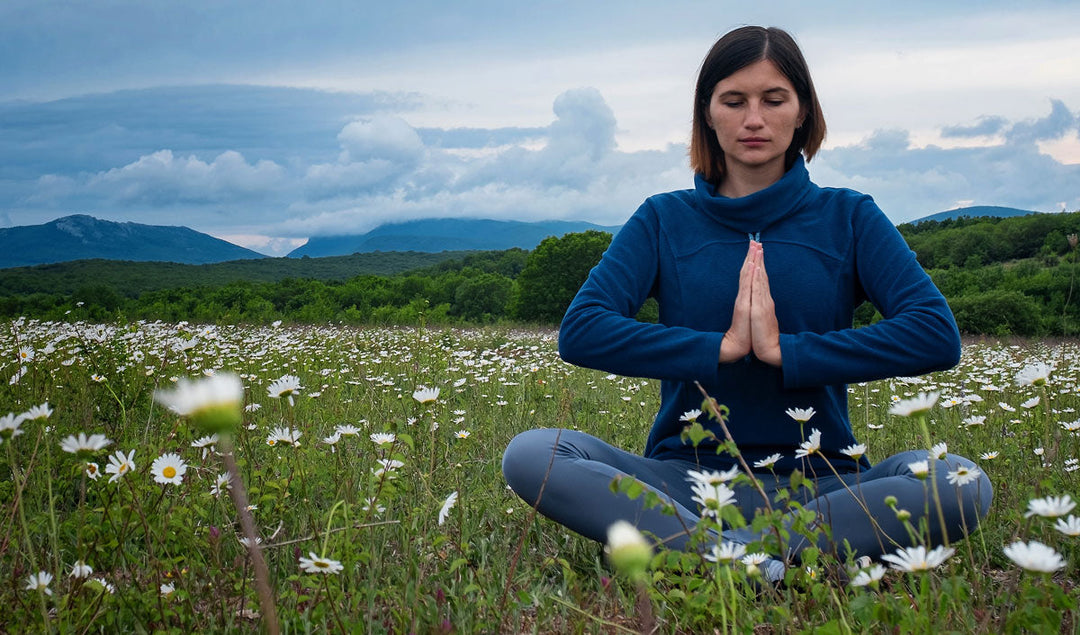The Power of Mindfulness: Reducing Stress and Anxiety Naturally
With so many of us facing mental exhaustion, depression, and burnout, mindfulness practices can be incredibly beneficial for restoring balance in our lives.
Mindfulness, or the practice of being present and aware in the moment, has been gaining immense popularity over the past few years. Focusing on the present can help reduce stress and anxiety, as well as other mental health issues.
By learning how to be mindful, we’re able to become more aware of our thoughts and feelings, allowing us to better manage our reactions to stressful events. Practicing mindfulness also helps us recognize when we’re feeling overwhelmed or anxious before these feelings spiral out of control. As a result, we're more likely to remain calm during difficult situations instead of becoming overwhelmed with emotion or stress.
There are several different techniques that can be used to foster mindfulness practices.
Deep breathing exercises are one of the most powerful tools for promoting mindfulness.

They encourage us to become aware of our own breath and body, while allowing us to relax and quiet the mind. When we practice deep breathing, we are able to consciously acknowledge any tension or stress in the body – then intentionally let it go.
A deep breath helps calm and regulate our nervous systems, reducing anxiety, fear and stress-related hormones like cortisol. It also increases oxytocin levels which has a calming effect on both mind and body.
Additionally, studies have shown that slow and intentional breathing can reduce symptoms of depression, improve emotional regulation, decrease pain perception and even improve cognitive functioning. There are many different types of deep breathing exercises ranging from simple diaphragmatic breathing to more complex yoga practices such as Pranayama (breath control) or Nadi Sodhana (alternate nostril breathing). Whatever type of technique you use though, they all have one thing in common: they help you focus on your present moment experience with an open heart and clear mind. This is what natural health and healing is all about – learning how to be mindful of your thoughts and feelings so you can create balance in your life.
Deep Breathing For Beginners:
- Begin by finding a comfortable and relaxed seated or standing position. Close your eyes if you’d like, but make sure to keep your spine straight and head slightly tilted up.
- Place one hand on your chest and the other on your abdomen, just below the navel.
- Inhale deeply through your nose, ensuring that your abdomen expands more than your chest.
- Exhale slowly and completely, allowing you to relax even deeper into the exercise with each breath out.
- Repeat this sequence of deep inhales and slow exhales for at least five minutes or until you feel relaxed and rejuvenated.
The benefits of deep breathing are far-reaching. Not only does it reduce stress, but it can also improve overall health and well-being. Deep breathing encourages the body to release natural healing agents like endorphins which can help alleviate physical pain, ease tension, and boost mood. It’s also been shown to reduce inflammation and regulate blood pressure, making it a powerful tool for natural health. So the next time you’re feeling stressed out or overwhelmed, take some time to practice deep breathing. You won’t regret it!
Guided imagery helps ground us in the present moment while engaging our creative abilities by imagining calming scenes or scenes related to our goals.

Guided imagery is a powerful tool used to relax both the body and mind. It works by creating mental images of calming scenes, helping us to become deeply rooted in the present moment while also allowing us to engage our creativity and manifest our goals. Through visualization and meditation, guided imagery can help us achieve a heightened state of awareness that promotes natural health and healing.
By focusing on soothing scenes or positive affirmations, we can reduce stress levels, decrease pain perception, improve mental clarity and even increase overall sense of wellbeing. Furthermore, it can be used for self-improvement or goal setting by visualizing scenarios related to our desired outcomes. Guided imagery has been seen as highly effective in providing long-term relief from a variety of physical illnesses as well as mental health issues.
Instructions for Guided Imagery Exercise For a Beginner:
- Find a quiet and comfortable place to sit.
- Take a few deep breaths in and out.
- Close your eyes and imagine a peaceful scene. It could be a beach, a meadow, or any other beautiful environment that you can think of. Envision the colors, the smells, and sounds of this place. Stay in that environment for a few moments.
- When you’re ready, open your eyes and take some time to reflect on what you just experienced.
Guided imagery is an amazing tool that can help us gain insight into our lives and health concerns. By taking some time each day to practice this technique, you can begin to reap the many benefits of natural healing. Plus, it’s fun and easy! So give it a try today and see how your body responds. You never know what magical things may happen! Happy imagining! 🔮 🌟 💫
Mindful listening allows us to appreciate sounds around us and better connect with others emotionally by paying attention to their words and expressions rather than just hearing them.

Mindful listening is an important tool for self-care, offering many benefits to both our mental and physical health. It encourages us to be fully present in the moment and open to the world around us and its vast array of sensory stimuli. By tuning out the noise of our inner dialogue or external distractions, we can gain a greater appreciation for subtle sounds like a bird's song or a baby's laughter.
Listening with mindful attention also allows us to better connect with others emotionally by paying attention to their words and expressions rather than just hearing them. This can help to foster deeper connections and understanding in relationships as well as cultivate empathy and compassion for those around us. In addition, research has found that mindful listening can reduce stress levels and improve overall wellbeing by releasing feel-good hormones such as oxytocin while decreasing cortisol levels.
Finally, mindful listening can even have physical benefits such as improved heart health due to reducing blood pressure levels. The benefits of mindful listening go beyond just mental and emotional health; it can also provide natural healing for physical ailments. Mindful listening to one's own body helps us to become aware of any physical discomforts or pains we may be experiencing before they get worse, allowing us to address them with natural health remedies such as herbal teas, aromatherapy, massage, exercise or dietary changes. This can be especially beneficial for those suffering from chronic pain as it helps to better understand and manage the physical symptoms.
Being in tune with our bodies also encourages us to take preventative measures before an illness or injury occurs by being mindful of any early warning signs such as fatigue, headaches or dizziness.
Instructions for Mindful Listening Exercise:
- Sit in a comfortable position – you can sit on the floor, in a chair, or cross-legged. Make sure your back is straight and your feet are firmly planted on the ground. Close your eyes and take a few deep breaths to relax.
- Focus on your own body and the sensations it is experiencing. Become aware of how parts of your body feel – for example, if you are sitting cross-legged, become aware of the pressure of your feet against the ground and the feeling in each toe individually.
- Notice any areas that feel tight or sore or tense and allow those sensations to be without judgment or expectation.
- Gently shift your awareness to any sounds around you – the hum of a fan, the ticking of a clock, or traffic outside. Notice them come and go without trying to change them in any way.
- Allow yourself to be curious about each sound – notice its texture, pitch, and volume.
- Bring your awareness to your breath – the sensation of air entering and leaving your body, the temperature of that air, and the feeling of it moving through you.
- Lastly, move your attention inwardly and become aware of any thoughts or feelings that may be present. Again notice them without judgment or expectation, allowing them to come and go as they please.
By practicing mindful meditation, you can gain deeper insight into your physical and emotional states, allowing for natural health and healing to take place. Research has shown that mindfulness brings about positive changes in our brains – reducing stress, increasing focus, improving sleep quality, and even boosting our immune system. So why not make a commitment to yourself and give it a try? You never know how much better you could be feeling!
Other popular mindfulness exercises include: progressive muscle relaxation, body scanning meditation, and self-observation meditation.
The Research & Results are Clear
Research has shown that mindfulness practices can have a significant impact on reducing stress levels and improving overall wellbeing. A study published in Frontiers in Psychology found that participants who practiced mindful meditation experienced lower levels of stress after just eight weeks compared with those who didn't receive any intervention at all.(1) Similarly, another study published in Cognitive Behavioral Therapy found that participants who underwent an eight-week mindfulness course had significantly lower levels of anxiety compared with those who did not.(2)
Overall, these findings show that practicing mindfulness can be incredibly helpful for managing stress levels and improving emotional wellbeing.
If you’re feeling overwhelmed or anxious due to life's various challenges or day-to-day responsibilities, incorporating some form of mindful practice into your daily routine can help you feel better equipped to cope effectively with life's obstacles. Whether it’s through deep breathing exercises or guided imagery meditations - taking even just a few minutes each day for yourself can make all the difference in how you feel mentally/emotionally!
Top 5 Websites to explore and learn about mindfulness
Two Important Books on Mindfulness by the masters:
Wherever You Go, There You Are: Mindfulness Meditation in Everyday Life by Jon Kabat-Zinn: This classic book was first published in 1994 and has since become one of the most recommended books on mindfulness meditation. It provides readers with a comprehensive introduction to core mindfulness concepts, as well as practical guidance for beginning a personal meditation practice.
The Miracle of Mindfulness: An Introduction to the Practice of Meditation
In this beautiful and lucid guide, Zen master Thich Nhat Hanh offers gentle anecdotes and practical exercise as a means of learning the skills of mindfulness--being awake and fully aware. From washing the dishes to answering the phone to peeling an orange, he reminds us that each moment holds within it an opportunity to work toward greater self-understanding and peacefulness.

















